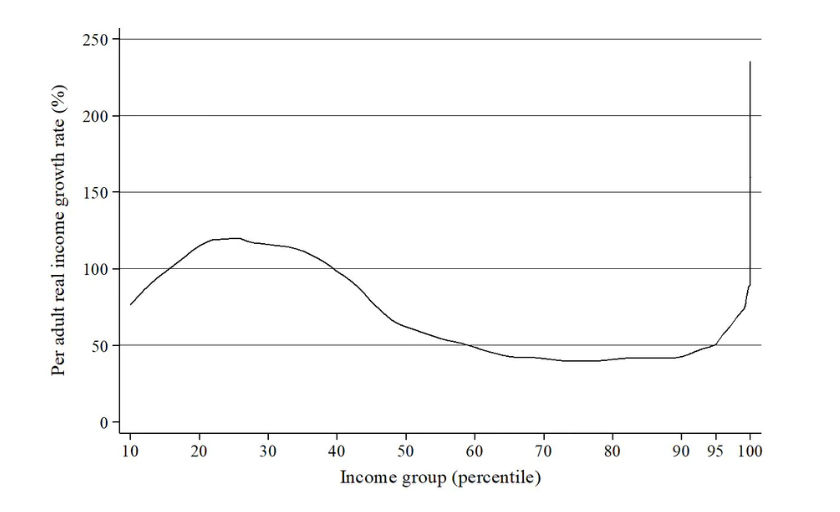Is Economic Justice Possible?
Toward a New Conception of the Equitable Distribution of Wealth and Income
By Navid Sabet

When calamity strikes, questions concerning the distribution of material resources often follow. The Great Depression gave birth to the New Deal, a series of sweeping government programs and reforms in the United States aimed at immediate economic relief for the “forgotten man.” The world wars saw the expansion and consolidation of the modern welfare state via a wave of nationalizations and other measures designed to provide a “cradle-to-grave” safety net in areas like health, education, housing, and retirement benefits. For today's generation, both the Great Recession of 2008 and the coronavirus pandemic of 2020 exposed great social and economic inequalities and reinvigorated debate as to the causes and consequences of the unequal distribution of economic resources and opportunities. Both crises spurred governments to levels of unprecedented social spending, hundreds of billions to prevent the failure of banks in 2008/9 and hundreds more billions—even trillions—to prevent the grave consequences of mass unemployment in 2020. Yet, notwithstanding renewed interest in the topic and bold government action, and despite the fact that humanity is currently enjoying unprecedented levels of material prosperity, the distribution of material resources—of wealth and income in particular—has grown ever more unequal. In fact, according to one social historian, inequality has, since the Stone Age, always been rising, and only four forces—the “Four Horsemen of Leveling”—have ever managed to lower it: pandemics, mass warfare, revolution, and state collapse. Today, 20 percent of the global income is owned by the richest 1 percent of the world's population whereas the poorest 50 percent own just 9 percent. The choice thus appears to be either to come to terms with ever rising levels of inequality or hope for disaster. Must it really be so?
The Bahá’í Teachings explain that the inordinate disparity between rich and poor is a “source of acute suffering” which “keeps the world in a state of instability.” Furthermore, the negative consequences of extreme inequality have been documented by scholars of various disciplines. They include social and political instability as well as threats to environmental sustainability. At the individual level, inequality can lead to shorter, unhealthier, and unhappier lives, including increases in teenage pregnancy, violence, and obesity.
Of course, it is one thing to agree that inequality—at least in its extreme forms—is bad. For a religious person, it can be all too easy to fall into the trap of moralizing, on the basis of lofty spiritual principle, perceived or actual inequalities. The far more difficult task is to articulate a coherent conception of what sort of equality is good. This is a challenging question, one with a long philosophical tradition that focuses on such things as equality of opportunity, equality of outcomes, fair versus unfair inequality, and more. The purpose of this article is to stimulate reflection on these matters by setting out a number of principles contained in the Bahá'í teachings related to distributional issues and by connecting these principles to today's economic conditions. The Bahá'í concept of social change envisions the transformation of human society to be the aggregate of two other interlocking transformations: that of the individual and that in the structures of society. The article, therefore, discusses principles intended to stimulate reflection on both the collective and individual levels and highlights, where possible, potential mechanisms—public policy and political participation, to name just two examples—through which these principles might find practical expression.
In attempting to correlate Bahá'í principles to current economic conditions, this article presents a number of facts concerning the global distribution of income, facts drawn from measures collected by leading academic economists. The interested reader is invited to consult the technical appendix for a more thorough description of what these data measure and the caveats associated with them.
The Bahá'í Teachings on (In)Equality
The distribution called for in the Bahá'í Writings is not to be understood as absolute equality. In this respect, Shoghi Effendi writes that “[s]ocial inequality is the inevitable outcome of the natural inequality of man. Human beings are different in ability and should, therefore, be different in their social and economic standing.” ‘Abdu’l-Bahá elaborates this idea, explaining that people differ in their capacities and should thus “receive wages that would correspond to their varying capacities and resources.” According to the principle of divine justice, perfect equality is not just undesirable but unattainable. In this connection, ‘Abdu'l-Bahá explains that by divine justice,
[i]t is not meant that all will be equal, for inequality in degree and capacity is a property of nature. Necessarily there will be rich people and also those who will be in want of their livelihood, but in the aggregate community there will be equalization and readjustment of values and interests.
What matters more than equality in outcomes is an equal chance to succeed, “justness of opportunity for all,” according to ‘Abdu'l-Bahá. Today, however, social mobility is as restricted as income is concentrated, even when one considers the efforts of some nations, most notably China and India, to lift many millions out of extreme poverty. This is made clear in Figure 1. On the horizontal axis, the world population is divided into one hundred groups of equal population size and sorted in ascending order from left to right, according to each group's income level. The vertical axis shows the total income growth of an individual in each group between 1980 and 2016. As shown, individuals in the top 1 percent saw their incomes rise by more than 100 percent over the time period whereas individuals in the top 0.01 percent experienced income growth of more than 200 percent. Calculations by the authors who collected the data indicate that, while those in the bottom 50 percent did experience some income growth, they collectively claimed just 12 percent of total income growth from 1980 to 2016. Those in the top 1 percent, by contrast, claimed 27 percent over the same period. The figure is a powerful illustration of how sharply the incomes of the richest segments of society have grown, especially when compared to increases in other groups.

How much is too much?
According to the Bahá’í Teachings, the solution to many of the economic problems that afflict humanity appears rather simple: moderation. That is, while some degree of inequality is natural, the Bahá’í teachings unequivocally call for the elimination of the extremes of wealth and poverty. ‘Abdu’l-Bahá speaks of the “equal opportunity of the means of existence” whereby “a rich man is able to live in his palace surrounded by luxury and the greatest comfort” just as a “poor man be able to have the necessaries of life.” The “readjustment in the economic conditions of mankind” that ‘Abdu'l-Bahá envisions will be such that
in the future there will not be the abnormally rich nor the abject poor. The rich will enjoy the privilege of this new economic condition as well as the poor, for owing to certain provisions and restrictions they will not be able to accumulate so much as to be burdened by its management, while the poor will be relieved from the stress of want and misery.
Though seemingly simple, striking the right balance in wealth distribution has proven immensely difficult. Table 1 provides one example of wealth distribution in the richest country of the world, the United States. The table shows how much wealth a family requires to belong to different percentiles of the income distribution. The top 1 percent of earners in America consists of just over 1.5 million families. To belong to this group, a family requires $3.9 million; the average wealth of all families in this group stands at $13.8 million. To be counted among the 16,070 families in the top 0.01 percent of the distribution requires a staggering $111 million of wealth. In contrast, there are nearly 145 million families in the bottom 90 percent of the income distribution. These families each have, on average, $84,000 in wealth.
Table 1. Thresholds and average wealth per wealth group, USA 2012

To demonize wealth is not the point. Quite the contrary. The Bahá'í teachings not only prohibit asceticism but regard wealth as “praiseworthy in the highest degree” provided it is (a) acquired through honest means and (b) used to advance philanthropic purposes. Although the Teachings warn against luxury and excess, Bahá’u’lláh enjoins us to use our wealth as a means to achieve worthy ends. “The best of men,” He writes, “are they that earn a livelihood by their calling and spend upon themselves and upon their kindred for the love of God, the Lord of all worlds.”' Aside from the prohibition against asceticism, Bahá’ís are also discouraged from adopting austere lifestyles. In response to a letter received on the subject, Bahá'u'lláh writes the following:
Thou hast written that they have pledged themselves to observe maximum austerity in their lives with a view to forwarding the remainder of their income to His exalted presence. This matter was mentioned at His holy court. He said: Let them act with moderation and not impose hardship upon themselves. We would like them both to enjoy a life that is well-pleasing.
Addressing inequality from the top and bottom
The issue, instead, appears to be one of economic justice based on our interconnectedness. One wonders, for example, to what extent extreme wealth causes, and indeed is a consequence of, extreme poverty and whether policies that allow for the hyper-concentration of wealth simultaneously make it easier for the disadvantaged to fall into destitution. “The welfare of any segment of humanity,” the House of Justice writes, “is inextricably bound up with the welfare of the whole. Humanity's collective life suffers when any one group thinks of its own well-being in isolation from that of its neighbors.” ‘Abdu’l-Bahá, moreover, explains that “[w]ealth is most commendable, provided the entire population is wealthy.”
Given the interconnected nature of the human family, efforts to realize a more just distribution of economic resources must be addressed from both the top—by, for example, regulating and limiting the hyper-concentrated accumulation of wealth through taxation and other measures—and the bottom—via transfers and strong social spending. Calls to unleash economic growth, on the assumption that it automatically translates into an equitable distribution of resources, are unfounded. This is made evident in Figure 2 which plots trends in the share of national income accruing to the top 1 percent and the bottom 50 percent of earners in the global income distribution.

The above figure demonstrates two facts: differences in (a) levels and (b) trends between top and bottom earners. With respect to levels, those in the top 1 percent of the income distribution earn, on average, about 10 percentage points more of national income than those in the bottom 50 percent of the income distribution (19 percent for the top 1 percent compared to 9 percent for the bottom 50 percent). In addition, top earners are trending at three times the rate. Between 1980 and 2016, those in the top 1 percent of the income distribution increased their share of national income by 4.4 percentage points, from 16 percent to 20.4 percent. For those in the bottom 50 percent, their share of national income increased by just 1.5 percentage points over the same time period. More than anything, the figure casts significant doubt on the assertion—often used as justification for tax cuts for the wealthy—that rises in income at the very top provide wealth, opportunity, and incentives for those at the bottom. While a rising tide may lift all boats, structuring the economy so as to allow wealth to funnel upwards does not. In brief, economic justice requires that the rules that regulate the economy are fair and not tilted to the benefit of a particular segment of society to reinforce its enrichment.
Originally published from Baha'i World












